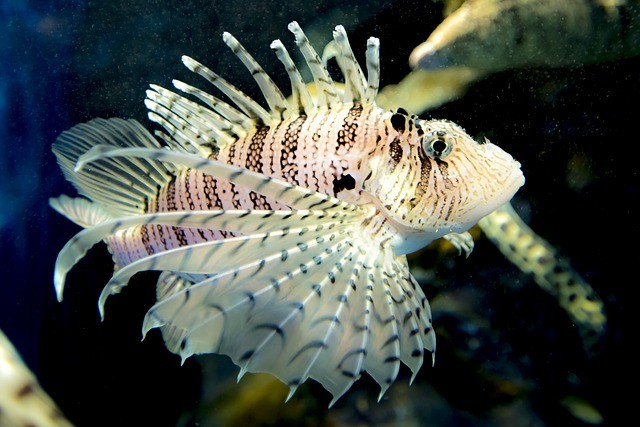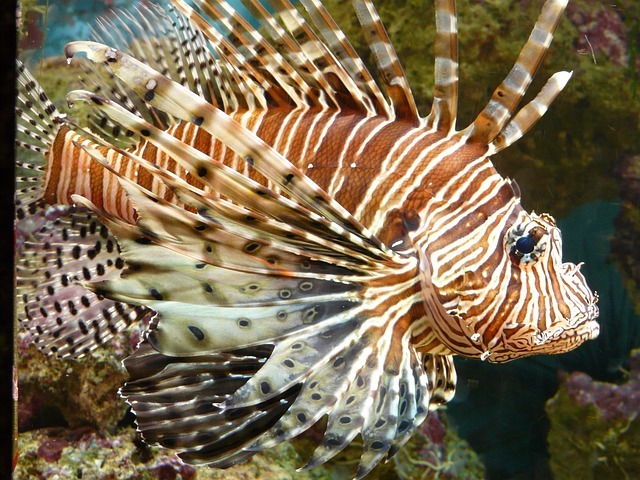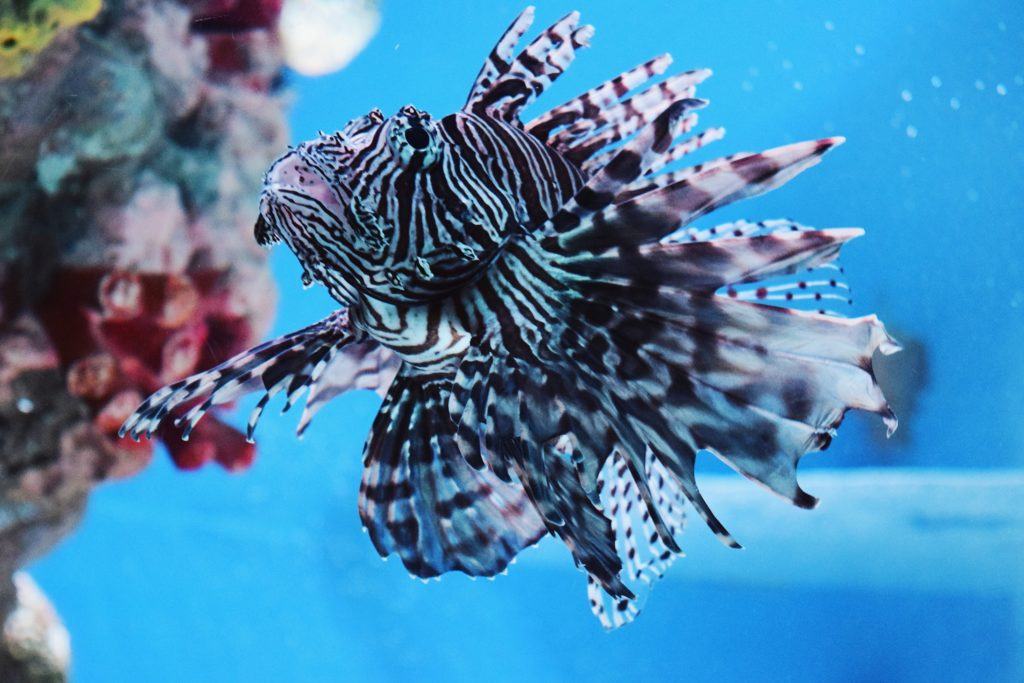Lionfish are a strikingly beautiful addition to any saltwater tank. Elegant and colourful, they are also equipped with poisonous spines and are voracious predators.
Don’t let this dissuade you; with some knowledge and basic care, these amazing fish can become a beloved and healthy part of your saltwater collection.
There are a few different kinds of lionfish available for purchase at most pet stores. Some of the best species for home enthusiasts are the Volitans Lionfish, the Russell’s Lionfish, the Spot-Finned Lionfish, and the Dwarf Fuzzy Lionfish.
While most of these lions have the same needs, they are different sizes and will require different tank sizes, but we’ll touch more on that later.
Contents
Lionfish Personality & Appearance
Lionfish are predatory and generally solitary fish.
While they are beautiful and ethereal, their long, colourful spines also pack a punch; their dorsal fins are poisonous and can feel like a strong bee sting if they catch your hand, so be sure to take care when feeding and cleaning the tank.
Lionfish are members of the scorpionfish family. In the wild, they are found in the Indo-Pacific oceans and the Red Sea.
These fish also have big personalities, and can quickly learn the feeding routines and become very responsive to their owners’ movements.
Tankmates
Being rather aggressive predators, lionfish should not be put in tank with any smaller fish, crabs, or shrimp, as they will very likely eat them.
You can put lionfish in a tank with other lionfish, as long as they are not closely related, as they may fight.
If one lionfish attacks another, they should be separated or the attacked lionfish may stop eating and die.
Try to make sure that with multiple lions, they are about the same size – or the larger may eat the smaller.
To protect your lionfish, avoid placing them in a tank with large eels, frogfish, and other scorpionfish, as they may eat your lionfish.
Large angelfish, pufferfish, and triggerfish are known for harassing lions and eating their dorsal spines, so it’s recommended to not put them together.
Blue Cheek, Pink-Tailed, and Niger Triggers are more peaceful, and should be fine to pair with your lion.
Tangs and rabbitfish make good tankmates, too.
Health Concerns
Disease can be introduced to the tank when you add anything that has not been properly cleaned or quarantined, including live rock, corals, and fish.
The best prevention is proper care and the cleaning of anything new going into the tank, as well as making sure that you provide quality food, clean good water, and proper tankmates.
Generally, lionfish are pretty hardy and disease-resistant fish. Sometimes, fish do get sick though.
Fin rot is a bacterial infection which can be treated with antibiotics, as is cloudy eyes. Lionfish can also contract ich, which is cured with hypo-salinity or copper-based medications.
Because lionfish have poisonous spines, it is important to handle them with care, and be particularly watchful when cleaning the tank.
Lions use these spines primarily as a defence, and while stings towards their owners are rare, they do occur.
If you do get stung, quickly immerse the stung site in hot but not scalding water (110-113 F) for 20 to 30 minutes, or until the pain decreases. Applying rapid heat through a hair dryer can also help.
The most frequent symptom of a sting is pain and swelling, and the wound could be tender or numb for a few days afterwards.
Some people do get allergic reactions; if the pain and swelling get worse over a few hours, see your doctor.
Here’s a video showing how to treat a lionfish sting.
Lionfish Care
Tank Requirements
Tank requirements will vary based on the type of lionfish, so we’ll go over individual needs for the four most common varieties.
All lionfish are appropriate for reef tanks, as they will not harm the coral, but be careful about tankmate selection, as they will eat smaller fish and ornamental shrimp or crabs.
Most lionfish will adapt to tank life and your individual lighting schedule, so the type of tank and setup therein is relatively flexible, within the following guidelines:
Volitans Lionfish (Terois volitans)
Growing to a maximum size of 12-15 inches, these fish need a minimum tank size of 85 gallons, with a tank at least 18” wide to make sure they have enough space to turn when fully grown.
They also like a place to hide, so a cave or protected nook is good for the health and well-being of your fish.
Russell’s Lionfish (Pterois russelli)
These fish are a bit smaller at 10-12 inches, and need a minimum tank size of 75 gallons.
They adapt easily to aquarium life and spend much of their time out in the open, especially when it comes to feeding time.
They grow fairly quickly, and can become up to 10 inches long in as little as one year, so consider starting them in a tank large enough to hold their final size.
Spot-Finned Lionfish (Pterois antennata)
A hardy, medium-sized lion, they can grow 8-9 inches long, and require a minimum tank size of 55 gallons.
These lions are shier than some other species and require lots of hiding spots.
Dwarf Fuzzy Lion (Dendrochirus brachypterus)
Probably one of the best types of dwarf lions to own, these hardy, disease-resistant little lions grow to 7-8 inches, and need a minimum tank size of 30 gallons.
They are active swimmers, especially at dawn and dusk, but during the day prefer to hang on soft corals or inside of caves, so make sure to give them a good spot to seclude themselves within.
Water Requirements
As with all fish tanks, the water, substrate, and decorations should be cycled in the tank before fish are introduced.
Many pet stores offer salt water ready to go, but you can also mix your own, which requires more work and precision.
The water in the tank should be kept at a temperature between 72 and 78 degrees Fahrenheit, with a salinity level of 1.020-1.026.
The rest of the water requirements should be about the same as any other salt water tank: low ammonia and nitrates, and nitrites less than .2 ppm.
Tank Set-Up
If you already have fish in your tank and want to introduce a lionfish, the best way to do so is in a quarantine tank first.
This not only keeps a potentially sick fish away from the others, but it allows the new fish to get used to the water and food you are providing, reducing stress.
Before you remove your lionfish from quarantine, make sure that the tank has plenty of places for the lionfish to hide.
Rearrange the current layout of your tank to distract the existing fish and remove any established territories.
Feed your current fish right before introducing the new one, which will make them less aggressive. It is also better to introduce more than one new fish at a time, as it reduces the chances of one new fish being singled out and aggravated.
And, as always, make sure you water is clean and appropriately balanced to reduce stress in all of the fish.
Keep in mind, because lionfish are predators and opportunistic eaters, they will eat smaller fish. If the other fish can fit in their mouths, they will probably try to eat them, so be sure to match your lions with appropriate tankmates.
We’ll touch more on this later.
Tank Maintenance
Once a tank is set up and the fish are happy, water changes are the best way to maintain a healthy tank.
Smaller tanks require more frequent water changes because toxins such as ammonia and nitrates build up faster compared to larger tanks.
For tanks with only fish, and no live rock or anemones, water changes should be as follows:
- Tanks up to 40 gallons: 15% water changes bi-weekly
- Tanks 40-90 gallons: 20-30% water changes monthly
- Tanks 100+ gallons: Once the water is aged and stable, 20-30% water change every six weeks
For reef tanks, water changes should be:
- Tanks up to 40 gallons: 5% water changes weekly
- Tanks 40-90 gallons: 15% water changes bi-weekly
- Tanks 100+ gallons: Once the water is aged and stable, 10% bi-weekly to 20% monthly
Lionfish Food
In the wild, lionfish eat smaller fish and invertebrates, but in the tank, they can be somewhat finicky. All lionfish prefer live food, and will eagerly eat feeder goldfish or rosy red minnows.
Unfortunately, these freshwater fish do not provide proper nutrition as the sole diet for lions, so it is important to feed them a variety of fresh and frozen seafoods.
Ghost shrimp are a good live feeder, as they are slightly more nutritious than other freshwater feeders.
After two weeks to a month of live feeding, lionfish owners should wean them off of live food and get them to accept frozen in order to create a well-rounded diet and ensure that your lion stays healthy for years to come.
So how do you get your lion to accept frozen food? The wiggling of live food is what triggers the fish’s attack response.
One of the better methods is to not feed the fish for 3-4 days, then introduce smaller intact fish like lancefish or silversides. Impale the dead fish on a clear acrylic rod (or “feeding stick”) and “wiggle” it away from your lion, but in full view.
This should hopefully convince your lion that it is alive, and trigger the attack response.
Once your lion is weaned onto frozen prepared foods, rotate various marine foods to ensure that its diet is properly varied, such as shell-on gulf shrimp, lobster tail, crabmeat, strips/chunks of marine fish (even bought from your local grocery store), and chunks of squid or octopus.
Once the lionfish learns to take these prepared foods, they will often learn that you are the food source, and beg for food constantly.
Don’t allow these gluttonous fish to tempt you—if fed continuously, they will grow too quickly, generate too much waste in the tank, or even become sick.
The best way to avoid overeating is to provide small to medium-sized chunks of food, and feed them to the point of seeing a small bulge in the abdomen 2-3 times a week.
You can starve them for a few days to accurately reflect their wild lifestyle, and three feedings a week is sufficient to ensure they grow at a proper rate.
Lionfish Conclusion
Overall, lionfish make a beautiful and elegant addition to your saltwater tank. With proper care, they are long-lived and hardy fish, and often develop a big personality to go with their showy spines.
Do you own any lionfish?






